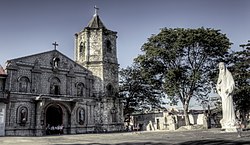Pagbilao | |
|---|---|
| Municipality of Pagbilao | |
From top, left to right : St. Catherine of Alexandria Parish Church • Zigzag Road, Quezon National Forest Park • Pueblo La Playa Resort | |
 Map of Quezon with Pagbilao highlighted | |
Location within the Philippines | |
| Coordinates: 13°58′19″N121°41′13″E / 13.972°N 121.687°E | |
| Country | Philippines |
| Region | Calabarzon |
| Province | Quezon |
| District | 1st district |
| Founded | August 29, 1730 |
| Barangays | 27 (see Barangays) |
| Government | |
| • Type | Sangguniang Bayan |
| • Mayor | Angelica P. Tatlonghari |
| • Vice Mayor | Walter G. Dapla |
| • Representative | Wilfrido Mark M. Enverga |
| • Municipal Council | Members |
| • Electorate | 50,829 voters (2025) |
| Area | |
• Total | 170.96 km2 (66.01 sq mi) |
| Elevation | 24.2 m (79 ft) |
| Highest elevation | 259 m (850 ft) |
| Lowest elevation | −1 m (−3.3 ft) |
| Population (2024 census) [3] | |
• Total | 82,132 |
| • Density | 480.42/km2 (1,244.3/sq mi) |
| • Households | 19,501 |
| Demonym | Pagbilawin/Pagbilaowin |
| Economy | |
| • Income class | 1st municipal income class |
| • Poverty incidence | 24.88 |
| • Revenue | ₱ 628.4 million (2022) |
| • Assets | ₱ 2,030 million (2022) |
| • Expenditure | ₱ 412.1 million (2022) |
| • Liabilities | ₱ 620.7 million (2022) |
| Service provider | |
| • Electricity | Manila Electric Company (Meralco) |
| Time zone | UTC+8 (PST) |
| ZIP code | 4302 |
| PSGC | |
| IDD : area code | +63 (0)42 |
| Native languages | Tagalog |
| Website | www |
Pagbilao, officially the Municipality of Pagbilao (Tagalog : Bayan ng Pagbilao), is a municipality in the province of Quezon, Philippines. According to the 2024 census, it has a population of 82,132 people. [5]
Contents
- Geography
- Barangays
- Climate
- Demographics
- Economy
- Government
- Elected officials
- Infrastructure
- Transportation
- Communications
- Education
- Primary and elementary schools
- Secondary schools
- Higher educational institution
- References
- External links
The name of Pagbilao is said to have been derived from the Tagalog words papag (bamboo beds) and bilao (winnowing basket). [6]








